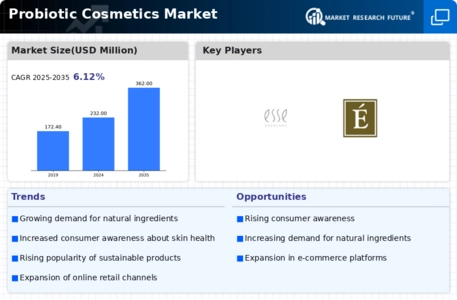Market Trends
Introduction
The Probiotics in Cosmetics Market is undergoing a significant transformation as we enter the year 2024. Increasingly effective formulation and delivery systems are enabling brands to take advantage of the interest and awareness of consumers who are increasingly concerned about the health of their skin. Also, regulatory requirements are shaping product development and pushing companies to adopt cleaner, more transparent practices that are also in tune with the preferences of consumers who are more concerned about the environment. Moreover, changing consumer preferences, such as the growing demand for multifunctional products that combine beauty with health benefits, are forcing brands to innovate and differentiate. In order to navigate these changes and to take advantage of the emerging opportunities, companies and investors need to understand these trends.
Top Trends
-
Increased Consumer Awareness
The demand for the use of probiotics in skin care has risen as consumers have become more aware of their benefits. A survey conducted in the United States in 2012 showed that a majority of consumers are willing to pay more for products that contain probiotics. Brands are responding to this trend by putting more money into educational marketing. Awareness of the benefits of probiotics is growing. As this awareness increases, it may become necessary for companies to develop new products to meet consumers’ expectations. -
Sustainability and Eco-Friendly Packaging
In fact, consumers are showing a marked preference for products that use sustainable packaging, with 65% of consumers indicating that this is the case. Accordingly, companies are responding by adopting biodegradable materials and reducing their use of plastic. These changes not only increase brand loyalty, but also reaffirm the commitment to sustainable development. Furthermore, the next step may be to develop new packaging that has an even lower impact on the environment. -
Personalization in Skincare
A new trend in cosmetics is emerging, the trend towards bespoke solutions for skin care. Brands are using artificial intelligence and data analysis to create bespoke probiotic formulas. This bespoke approach to the development of products increases customer satisfaction and retention. The future implications of this trend include more sophisticated algorithms for bespoke skin care recommendations. -
Integration of Probiotics with Other Active Ingredients
There is a growing trend to combine probiotics with other active ingredients, such as vitamins and antioxidants. This combination is appealing to consumers who are looking for products with multiple functions. It has been shown in research that this combination can improve the effectiveness of probiotics, and therefore the performance of the product. These combinations require companies to invest in research and development to find the right combination. -
Rise of Clean Beauty Standards
The pro-beauty movement is influencing the market for pro-biotic cosmetics, with 75% of consumers seeking products free of harmful chemicals. Brands are reformulating their products to meet these demands, which has the added benefit of enhancing their reputation and building trust with consumers. Authorities are also making it more difficult for companies to adopt these less polluting formulas. The certification of products that are pro-beauty is becoming more and more stringent. -
Expansion of E-commerce Channels
The e-commerce channel has become a major sales channel, and the sales of beauty products have increased by 30% in the past year. Brands are also investing in digital marketing and e-commerce platforms to reach more consumers. This trend has influenced the strategy of traditional retail and has become a new trend of direct-to-consumer. It is expected that in the future, the brand will have a richer e-commerce experience and more digital engagement strategies. -
Focus on Skin Microbiome Research
Research into the skin’s microflora is driving innovation in probiotic cosmetics. The balance of the skin’s microflora has been found to be directly related to the health of the skin. Companies are investing in scientific research to develop products that maintain the skin’s microflora. This is expected to lead to new product categories and to a greater degree of consumer trust in probiotic claims. Future developments will be based on collaborations with universities and research institutes. -
Influencer Marketing and Social Media Impact
Influencer marketing has a significant influence on consumers’ views. In fact, a survey conducted by the Ad Council in the United States found that 80% of consumers trust the recommendations of social media stars. Brands are using social media to increase their visibility and engagement. And as a result, they are increasing their budgets for influencer marketing. The rise of micro-influencers for niche marketing strategies may be a trend in the future. -
Regulatory Developments and Compliance
New regulations are being introduced in Europe for the use of probiotics in cosmetics. To avoid fines, companies must ensure that they comply with these regulations. This new trend is driving brands to invest in transparency and the tracing of raw materials. Moreover, in the future, we may see the appearance of stricter regulations that require detailed disclosure of the formulations. -
Emergence of Hybrid Products
A new hybrid trend is hybrid products that combine cosmetic and well-being benefits. A study found that a majority of consumers are interested in products that both care for their skin and provide well-being. Brands are therefore looking for new formulas to meet this demand. In the future, new product categories may emerge that blur the line between cosmetics and well-being.
Conclusion: Navigating the Probiotic Cosmetics Landscape
Competition in the pro-biotic cosmetics market is intense and highly fragmented, with both the big players and new entrants in the market competing for market share. The trend towards natural and sustainable products is encouraging manufacturers to innovate and adapt their products to these trends. The established players are relying on their brand equity to compete in the market, while deploying new technological tools such as artificial intelligence and automation to enhance product development and consumer engagement. New players are focusing on flexibility and sustainability to tap into niche markets. These are the capabilities that will be needed to succeed in this market as it develops.




Leave a Comment